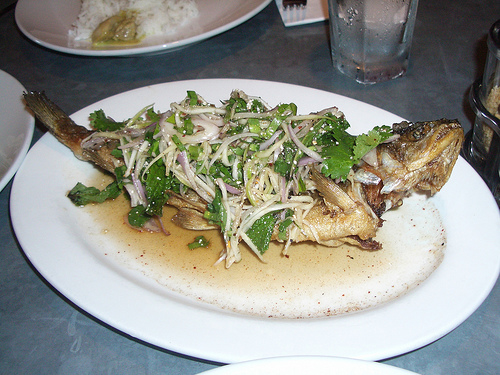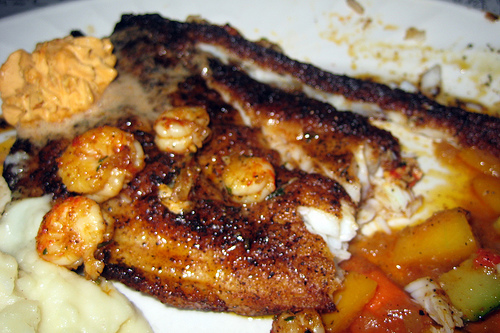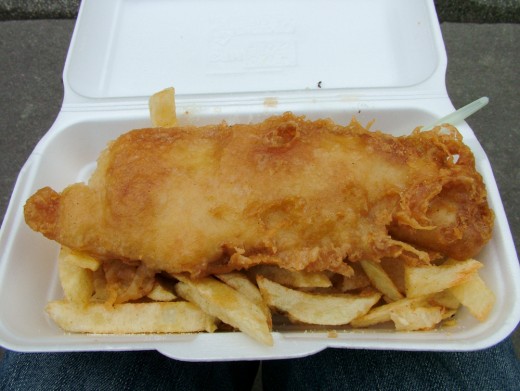Cooking Techniques for Lean Fishes
My husband and I are avid anglers. We like catching fish and eating fish, so we’ve tried numerous methods for cooking our catch. Almost all the fishes we target are lean fishes, with flaky flesh and a mild flavor. These types of fishes can be cooked in a wide variety of ways. Sometimes we just like to dredge the fillets in flour and deep fry, but sometimes we go to more elaborate measures.
Lean fishes lack the strong “fishy” taste inherent in fatty fishes, so they’re well complimented by a broad spectrum of herbs, spices, and other flavorings. Some of our favorites are dill, garlic, white wine, white pepper, lemon pepper, black pepper, beer, cayenne, teriyaki, chipotle powder, and citrus fruits.
Before we continue, let's have a quick vocabulary lesson. A "fillet" is the meaty section of the fish that's boneless. The skin may or may not have been removed. A "round fish," or a fish "in the round," has been scaled and gutted but is otherwise left whole. A "steak" is a cross-section of a fish.
Also, the English teacher in me needs to make one additional point. "Fish" can be singular or plural. One shark is a fish; two sharks are also referred to as "fish." The term "fishes" is used when you're talking about two or more species; one flounder, one trout, and one bass are collectively "fishes."
Below are general guidelines for different ways to cook lean fishes. Use your imagination and add your own favorites when it comes to herbs, spices, and other flavors.

Pan Frying
Pan frying can be done in a skillet or frying pan, usually with butter or oil that’s about 1/8-inch deep. This method works best for fillets, steaks, or small whole fish. Medium-high temperatures are used to create a brown “crust” on the fish – with or without a flour coating. Pan frying cooks the fish quickly. Add your favorite seasonings before or during cooking.
When the outside of the fish is golden brown and the flesh is flaky and opaque, it’s ready to eat.

Steaming
Steaming is a great way to cook delicate fillets, but it can also be used to cook small dressed fish whole. Herbs and spices can be placed in the steamer basket with the fish, or the flavors can be infused into the water before steaming.
Once the water has begun to boil, place the steamer over the water and add the fish and any desired seasonings. Steam for about 10 minutes per inch of fish thickness.

Baking
Baking is a wonderful way to cook fish in the round. With the whole fish, herbs and spices can be tucked into the cavity of the fish to provide extra flavor. The cavity can also be filled with a bread or crabmeat stuffing. The top side of the fish is usually drizzled with oil or melted butter to prevent drying.
Most fishes should be baked at 350-400 degrees, depending on thickness. Thicker fish should be baked at a lower temperature for a longer period. You’ll know the fish is done when the dorsal fin pulls easily from the flesh.
Learn the process of stuffing and baking a round fish by viewing the following video:

Blackening
This is done at a high heat, usually in a white-hot iron skillet, and it works best for medium to thick fillets. The cold fillets should be patted dry and then dipped in melted butter before placing in the hot pan - the butter will adhere better if the fish is cold. Seasonings like red pepper, black pepper, cayenne, lemon or lime juice, and/or thyme should be used to season the fillets.
With this method, the fillets are blackened or seared on both sides and served with melted seasoned butter. The outside of the fish should be crunchy, while the inside is moist and flaky.
You'll find my recipe for blackened fish below this article!

Broiling
Broiled fish should be cooked in the oven at a high temperature, where the heat comes from the top unit – the broiler. Fish can be seasoned with herbs, spices, soy sauce, teriyaki, fruit juice, or white wine, with or without butter or oil. Make sure the oven is preheated before cooking, and place the fish at least 4 inches from the broiler.
Broiling works best for thin to medium-thick fillets. When one side of the fish is brown, turn it over so that the other side can cook. Once both sides are brown, the fish is done.
For a different taste, try spreading the fillets with mayonnaise, grated parmesan, and your favorite seasonings before broiling.

Deep Frying
Whole round fish, fish steaks, and fish fillets are delicious deep fried. Choose an oil with a high smoke point. Peanut oil works well.
Fish should be dredged in some sort of coating before frying, like flour, cracker meal, cornmeal, or a commercial fish batter. If you want more batter, dip the fish in an egg wash or buttermilk before dredging.
Most fish should be fried at 350-360 degrees. The fish will be done when they’re golden brown – usually in 4-5 minutes.
If you'd like my recipe for buttermilk-fried fish, click the link below.

Grilling
Lean fishes are very low in fat. They’re wonderful on the grill, but they must be coated with oil or butter before being placed directly on the grill surface. Fish in the round, meaty steaks, and thicker fillets work best. Also, choose fish that have a firm texture, and leave the skin on fillets to help hold the flesh together. Most fish can be cooked in 10-12 minutes on the grill, depending on thickness.
Delicate fish like Dover sole will often fall apart when grilled. To help the fish remain intact while grilling, you might want to use a fish basket. This is a wire mesh flat basket that holds fillets or smaller whole fish on the grill.
Another option for grilling fish is to wrap them in thick aluminum foil. This works best for fillets, and you can add seasonings and butter or oil. The foil packet can be completely closed, or it can be left open to give the fish a smoky taste.

Poaching
With this cooking method, the fish is simmered in about an inch of high-quality water. Flavorings like garlic, peppercorns, parsley, dill weed, white wine, lemon juice, celery, onions, and/or bay leaf work well to create a court bouillon.
Bring the water and flavorings to a full boil, then simmer over low heat for about 20-30 minutes, allowing the water to be infused with the herbs and spices. Next, return the water to the boiling point. Reduce the heat once again to low, and add the fillets once the water has stopped boiling. Cover the pan and cook fillets for 5-7 minutes, depending on their thickness. Never allow the fish to boil!

Sauteing
For this method, you’ll need a sauté pan – a pan with a wide base and low sides. All ingredients are cooked at the same time, over medium heat, in a pre-heated pan. Use only a small amount of oil or clarified butter. You don’t want to fry the fish – you just want enough oil so that the fish will slide around easily. You might want to add slices of onions, peppers, or carrots. As the fish cooks, slide the pan around to keep the contents moving.
Cooking time depends on the thickness of the fish, along with how crowded the pan is with other ingredients.
Seasoning agents might include spices, herbs, white wine, sliced onions, bell peppers, or vegetables.

En Papillote
With this cooking method, the fish, along with herbs and other seasoning agents, is wrapped in parchment paper and baked. The packets help the delicate flesh remain intact and intensify the flavor of the added herbs and spices. This method usually requires a cooking temperature of 350 degrees, and most fish will cook completely in 15 minutes or less.
Pompano en papillote is a popular dish, and the process also works well with other mild, tender fillets.
For a quick tutorial of how to make fish en papillote, view the following video:

Smoking
Any whole dressed fish can be smoked. Fillets can also be smoked, but they need to be firm and fairly thick. Leaving the skin attached will help the flesh to remain intact.
Before placing on the smoker, the fish can be seasoned with herbs, spices, butter, olive oil, onions, or sliced lemons or limes. If you’re smoking fish in the round, the cavity is a great place for inserting your seasoning agents.
Most fish require about 2 hours of smoking time.
If you’re using an electric smoker, soak twigs or wood chips in water for several hours before placing on the burner. We like to use pecan wood, but you might prefer oak, hickory, apple wood, alder, mesquite, or peach.
Once your fish is done, you can eat it as is or use it in dips and spreads. Find easy recipes below.
Read related articles:
- Holle's Smoked Fish Dip and Smoked Fish Spread
These are great recipes to use for any leftover smoked fish you might have. We dont like the taste of fatty fish like salmon and mackerel, so Ive used only lean fishes in these recipes, like bass,... - A Cook's Guide to Lean Fishes
It seems that people are becoming more and more health conscious, especially when it comes to diet. As a result, fish has become an extremely popular dish, and many families try to consume at least a serving... - Southern Cuisine: Blackened Redfish
Theyre called red drum, red bass, channel bass, spot-tail bass, redfish, or simply reds. Whatever you call them, theres no denying theyre one of the most sought-after fish in the South. Theyre fun... - Southern Culinary Arts: Holle's Buttermilk Fried Fish
Welcome to my online cooking school! Today's lesson is the culinary art of frying fresh fish. Folks in the South love fishing. Well, allow me to narrow that down: folks in South Georgia love fishing! We...








